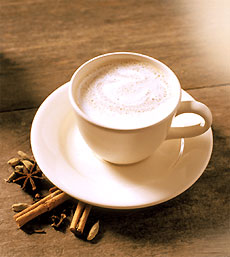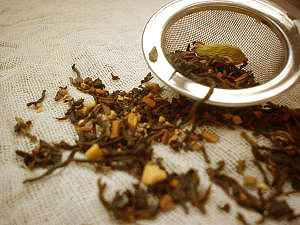  Start your day off right with a warm mug of David Rio Chai. Start your day off right with a warm mug of David Rio Chai.
June 2008
|
 |
David Rio Chai Mixes
Part I: Spice Up Your Life With A Cup Of Spiced Chai
CAPSULE REPORT: Chai is a sweetened black tea, enhanced with spices and milk—in essence, milky spiced tea. It is served throughout the day in India, and is enjoyed hot and cold. What green tea is to Japan, chai tea is to millions on the Indian subcontinent, who enjoy the refreshment of a sweet, spicy hot drink. “Chai tea” is a redundant term, since chai is the Indian word for tea. Spicy hot chai is a year-round beverage—after all, think of how hot it is in India! Instead of brewing tea with spices and adding milk, David Rio, a California company, has powdered mixes that just require water. There are regular, decaf and sugar-free versions, all dairy-free. This is Part I of a three-part article. To read parts II and III, click on the black links below.
About Masala Chai
Chai is more formally known as masala chai in Hindi (masala = a mixture of spices, chai = tea, after the Chinese word cha). The word rhymes with sky. Chai is also a basic tea in Nepal, Pakistan and Tibet. As with most food and beverages, the recipe varies based on the establishment or individual preference at home (many Indian families blend their own, rather than purchase a blend).
The roots of the recipe are more than 5,000 years old, traded to the Hindu natural healing system of ayurveda, which believes in the combining of spices, herbs and sweeteners to cure bodily ailments. A chai recipe begins with a strong black tea—often Assam, one of India’s prized teas—which can hold up to the spices and sweeteners.
With the growing popularity of chai in the U.S. over the past decade, many Western variations have been created: green tea chai, herbal chais with rooibos (red tea), chai-spiced yerba maté and the inevitable chai latte at your favorite coffee chain. Westerners, to make the product sound more familiar, have called it “chai tea” and “chai latte.” Neither of these terms is correct; chai is already a drink made with milk, so it is not a “latte,” made by adding milk; and since chai means tea, then you are asking for a tea tea.
Just as salt is used in savory recipes to bring out the flavor of the other ingredients, a sweetener is necessary to bring out the flavors of the spices. In India, the sweetener is more likely to be brown sugar, demerara sugar, coconut sugar, palm sugar or honey, but white table sugar is perfectly fine for sweetening chai. Each of these adds a different dimension of flavor to the chai. See our Sugar Glossary to learn more about the different types of sugar. Whole milk is the milk of choice to provide the right level of richness, but nonfat milk or nondairy milks (soy milk or rice milk, for example) also work well.
Masala Chai Spices
All you need to brew your own chai are the spices, which are ground with a pestle, and then add the mixture to hot water to steep. The mixture is strained and then mixed with milk and sweetened with honey. Recipes may differ, but there are some essentials.
Different companies sell blends, and each blend will taste different, highlighting different spices (even different black teas). Cardamom is generally the top note, but other flavors include cinnamon, cloves, ginger, nutmeg, peppercorn (usually not included in U.S. blends) and star anise. Sometimes the herb fennel is added. If you’re buying a prepared blend, check the label: Most blends are just tea and spice; you add your own sweetener (and milk, of course).
Based on the principles of ayurvedic medicine, chai is credited with relieving stress, settling an upset stomach and aiding with digestion.
|
 In the center of the tea ball is a green cardamom pod. Cardamom is the central spice of masala chai. See the recipe to make your own masala chai from scratch. If you use a spice ball, you don’t need to strain the tea. Photo by Meghan Anderson-Colangelo | SXC. In the center of the tea ball is a green cardamom pod. Cardamom is the central spice of masala chai. See the recipe to make your own masala chai from scratch. If you use a spice ball, you don’t need to strain the tea. Photo by Meghan Anderson-Colangelo | SXC. |
Caffeine In Chai
Chai has less caffeine than coffee or tea; and this spiced tea drink has fewer calories than tea because milk takes up a good portion of the eight ounces. Here’s a caffeine comparison from David Rio:
| |
Caffeine Per 8-Ounce Cup |
| Drip Coffee |
55 mg |
| Black, Oolong & Green Tea |
20 to 30 mg |
| Masala Chai |
10 to 15 mg |
| Herbals/Tisanes |
0 mg |
Continue to Part II: David Rio Chai
Go To Article Index Above

|





